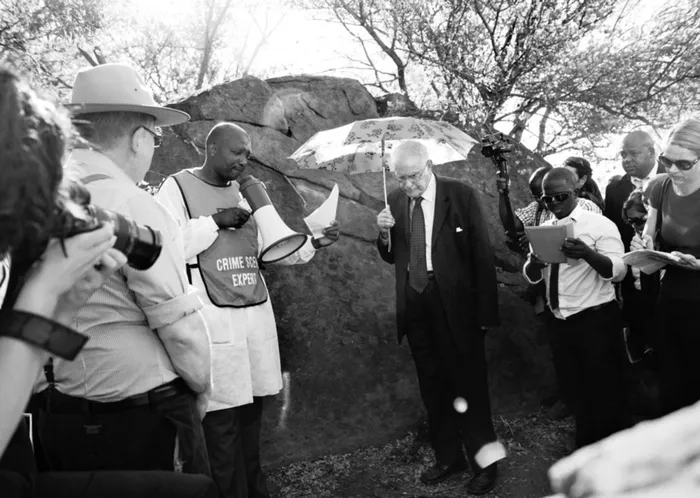Surprises as Marikana inquiry begins

011012. Wonderkop Informal Settlement in Marikana near Rustenburg, North West. Honourable Judge Ian Gordon Farlam with his panel listens to the police crime expert during the inspection of the scene where Lonmin mineworkers were killed by police in Marikana, the commission at the scene they are from the public hearing of the Marikana Commission of Enquiry to investigate the Marikana tragedy at which 44 people were killed and scores injured. Picture: Dumisani Sibeko 011012. Wonderkop Informal Settlement in Marikana near Rustenburg, North West. Honourable Judge Ian Gordon Farlam with his panel listens to the police crime expert during the inspection of the scene where Lonmin mineworkers were killed by police in Marikana, the commission at the scene they are from the public hearing of the Marikana Commission of Enquiry to investigate the Marikana tragedy at which 44 people were killed and scores injured. Picture: Dumisani Sibeko
Johannesburg - The markings on the koppie near Marikana, indicating the spots at which some mineworkers had lain dead immediately after the Marikana shootings, have been defaced.
The police officer who had performed the task told Marikana Commission of Inquiry chairman Judge Ian Farlam he didn’t know who had done this.
The commission of inquiry got under way on Monday, more than a month after President Jacob Zuma announced its establishment shortly after the August 16 Marikana massacre, during which 34 people were killed.
The proceedings began at the Rustenburg Civic Centre, where the commission will be based, with the reading of the names of all the victims who died during the labour troubles.
A minute of silence was observed in honour of those who died between August 9 and 16 - the day of the police shootings.
The auditorium was empty and the seats allocated to families of the dead miners remained unoccupied.
Advocate Dumisa Ntsebeza SC, who represents 20 families of the dead men, said their families, particularly those from the Eastern Cape, were not aware of the inquiry.
Ntsebeza, who also represents “the man in the green blanket” Mgcineni Noki, one of the leaders of the striking workers, among others, asked for the commission to be postponed for two weeks to facilitate the families’ arrival in Rustenburg.
“Families are keen to be at the proceedings… this will assist them with closure. They’ve got a right to be present here and a right to be assisted to be present,” said Ntsebeza.
After a long deliberation, Judge Farlam refused Ntsebeza’s bid and explained that the Department of Social Services was assisting the families.
The commission later reconvened in Marikana at the scene where 34 striking miners were killed near the Nkaneng informal settlement on August 16.
Before proceedings began, a group of people arrived and started demonstrating close to the spot where the judge and his commissioners and other officials were standing.
Carrying placards reading “Don’t let police get away with murder”, the group, who identified themselves as the Marikana Support Campaign, were asked to keep their distance. They complied.
Police forensic officers took Judge Farlam and others around the extensive crime scene, where bodies had been left scattered.
The judge and his contingent were taken to the front of the kraal, which, according to the police, was where the first seven bodies were laid out. Five others were found against the kraal. One was found between the kraal and a shack in Nkaneng and two more were found at the back. The 16th body was found at the back of some shacks, a distance away from the kraal.
The forensic officer said spent cartridges of rubber bullets, pistols and R5 rifles as well as stun grenades were found afterwards. He emphasised that lots of them had been from rifles.
The judge and his group were also taken to the koppie, where more than 10 people were killed.
An officer, who identified himself as Captain Motlhake, pointed to two scenes around the koppie, where he said he had found two bodies and bullet casings nearby.
He pointed to defaced letters in bright green paint that he said marked the spots where bodies had been found, except for F, which marked a spot where a firearm was found. Motlhake said he had been told some time later of the defacement.
The inspection was expected to resume on Tuesday with a visit to the mineworkers’ residences, including the hostel and the informal settlement, as well as a scene near the Karee mine where two police officers and three men were killed on August 13.
Judge Farlam emphasised the importance of seeing the living conditions in Marikana.
Advocates George Bizos and Dali Mpofu are representing the other families.
poloko.tau@inl.co.za
The Star